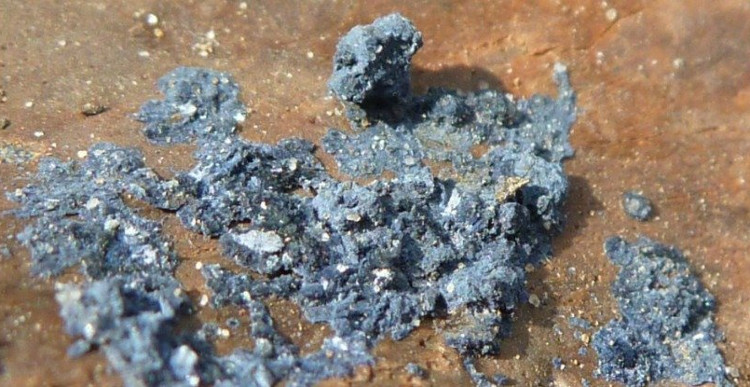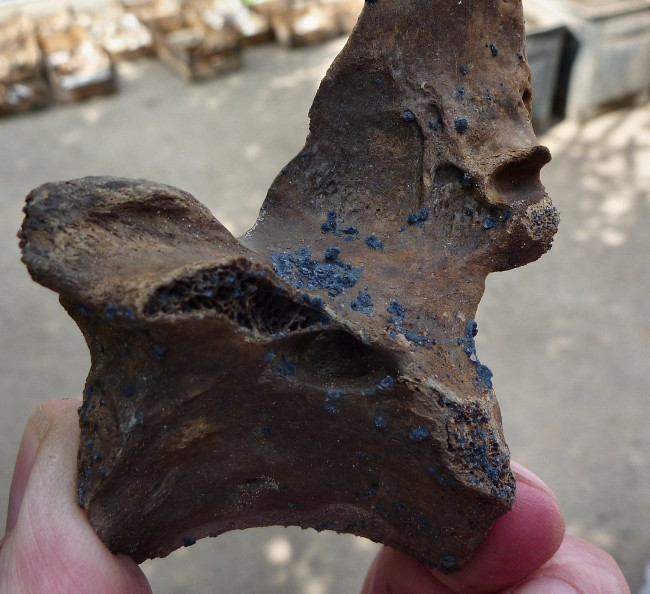Strange minerals form on the remains and make the bones green
If you've ever been close and closely watched the Ötzi Iceman (5,000-year-old natural mummy frozen in Alps, famous for his tattoos and curse mummies), you'll notice green spots. tiny on the skin of this mummy .
At first, they appeared as Ötzi's odd green crystals on his skin when he died of frost or some body wounds, but it was actually a mineral called vivianite (or iron ore). green) and this mineral is formed quite often on dead bodies left in iron-rich environments.

Minerals vivianite.
For Ötzi, small vivianite spots were formed due to the fact that the dead kin were located near rocks containing iron ore, but in some other cases the occurrence of vivianite was even more intense.
According to Chris Drudge in Atlas Obscura newspaper, a man named John White was buried in a cast iron coffin before 1861. At that time, the casket usually had a glass window for relatives to have. You can look inside even if the lid of the coffin is closed during the funeral.
Some time after the burial, the window broke, allowing groundwater to flow inside the casket with cast iron and impacting his body.
More than a century later, White was excavated due to land changes in the area. It was a shock to everyone around, they found his body turned completely blue with many large blue vivianite crystals formed on his body and inside the coffin.

Image of vivianite mineral on a bone buried in sand.
Vivianite is also found on the remains of US soldiers killed in a plane crash in Vietnam. Researchers were able to explain the appearance of minerals because soldiers were almost buried in moist soil with their aircraft fragments, which allowed vivianite to be formed.
These are just a few examples in many other cases where archaeologists have witnessed the encroachment of minerals on unearthed corpses.
So what's going on here?
It can be said, all due to the chemical reaction of phosphates (PO43-) with iron and water. While our bodies are made up of many different molecules, the most important thing for the formation of vivianite is phosphate , fortunately it is found throughout the body.
"Phosphates appear in hard bones and teeth, help bind DNA and RNA, it is used by cells to store and move energy around and help to combine many types of proteins," Drudge explained.
So when a person dies and begins the decomposition process, all of these phosphates leak into the environment around the corpse.
If the environment is wet and filled with iron, like White's coffin or Ötzi's ice tomb, phosphates will work with other molecules to form vivianite minerals.

Scientists are excavating a skeleton.
When newly formed, these crystals are colorless but when they act on oxygen in the air, they quickly become green. That creates a strange sight for anyone who finds dead bodies afterwards.
The formation of vivianite can both become good news and bad news for scientists trying to learn about the remains. For example, the formation of vivianite may help to better understand the composition of the burial ground and how the corpse is buried.
On the other hand, if you're working to try to analyze the DNA of the corpse, vivianite may be a curse, because it can prevent a conventional research method called polymerase chain reaction (PCR).
PCR involves collecting some DNA samples and copying them several times enough for researchers to analyze. But when vivianite has synthesized all phosphates, it can prevent the reaction from happening.
So the next time you read about an archaeologist discovering and seeing blue spots, know that it is vivianite and hope that the team's research does not include analyzing the DNA of the remains.
Another interesting thing, you can also review where you have chosen to rest, if it is a wet and iron-rich place.
- Wine and beer are good for bones
- The mystery of prone remains
- Decipher mysterious human bones in China
- Detecting strange minerals on the Moon volcano
- Special mineral mine found in Siberia
- Mysterious remains of women belong to another human species
- Mysterious minerals discovered in diamonds South Africa
- Found minerals in cosmic dust in Scotland
- The 5,000-year-old fist couple remains in Russia
- The 3,200-year-old remains have cancer
- Marvel at the remains of strange creatures with human legs and gibbon arms
- Ancient remains reveal our 'fishman' ancestors
 'Fine laughs' - Scary and painful torture in ancient times
'Fine laughs' - Scary and painful torture in ancient times The sequence of numbers 142857 of the Egyptian pyramids is known as the strangest number in the world - Why?
The sequence of numbers 142857 of the Egyptian pyramids is known as the strangest number in the world - Why? History of the iron
History of the iron What is alum?
What is alum?